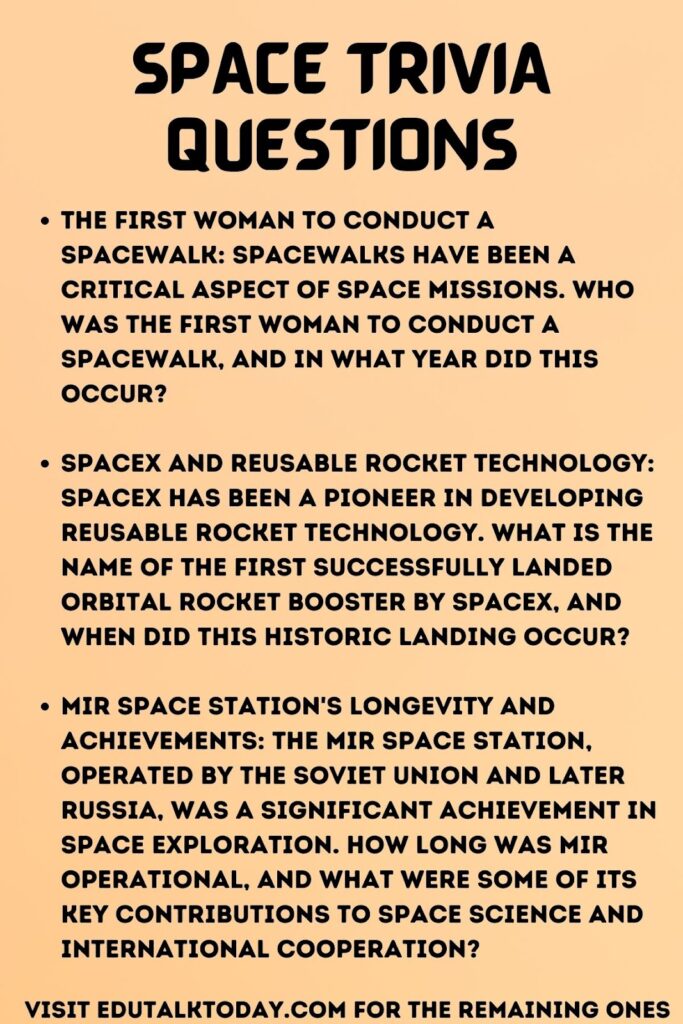33 Space Trivia Questions

Are you ready to embark on a journey through the cosmos and challenge your knowledge of outer space?
Space is a vast and mysterious frontier, filled with fascinating facts and mind-boggling phenomena.
Whether you’re a seasoned astronomy enthusiast or just curious about the universe, these space trivia questions will surely pique your interest and put your cosmic knowledge to the test!
Let’s begin.
Space-Themed Trivia Questions
- The Voyager Probes’ Golden Records: NASA’s Voyager 1 and 2 spacecraft, launched in 1977, carry something unique known as the Golden Records. These phonograph records contain a diverse range of sounds and music from Earth. What specific types of audio are included on these records, and what is the primary purpose of these records?
- Valentina Tereshkova’s Space Milestone: In 1963, Valentina Tereshkova became the first woman to fly into space. What spacecraft did she pilot, and what were some of the notable achievements or records set during her mission?
- The Hubble Space Telescope’s Deep Field Image: The Hubble Space Telescope has captured many stunning images, but one of its most significant is the Hubble Deep Field image. When was this image taken, and what is its significance in terms of understanding the universe?
- The Composition of Saturn’s Rings: Saturn is known for its magnificent ring system. What are Saturn’s rings primarily composed of, and what are some of the theories about how they were formed?
- The Mars Rover ‘Curiosity’: NASA’s Mars Rover Curiosity has been exploring Mars since 2012. What were the primary objectives of the Curiosity mission, and what are some of the key discoveries it has made?
- The Sun’s Life Cycle: The Sun is a G-type main-sequence star (G2V). Can you describe the stages of the Sun’s life cycle from its formation to its eventual transition into a red giant and ultimately, its end state?
- The International Space Station (ISS): The ISS is a marvel of international cooperation in space. What are the primary purposes of the ISS, and what are some of the unique features or components that make it suitable for its role?
- Neptune’s Wind Speeds: Neptune is known for having some of the strongest winds in the solar system. How fast can these winds reach, and what factors contribute to these extreme speeds?
- The Discovery of Exoplanets: The first confirmed detection of exoplanets orbiting a main-sequence star was a groundbreaking event in astronomy. When did this discovery occur, which star were these planets orbiting, and what method was used to detect them?
- The Kuiper Belt and Its Significance: The Kuiper Belt is a region of the solar system beyond Neptune. What are the primary characteristics of the Kuiper Belt, and why is it significant in terms of understanding the formation and evolution of our solar system?
- The Pioneer Plaques: Similar to the Voyager Golden Records, the Pioneer 10 and 11 spacecrafts, launched in the early 1970s, also carried a unique message to extraterrestrial life. What was depicted on these plaques, and what was their intended purpose?
- Black Holes and Event Horizons: A black hole is a region in space where the gravitational pull is so strong that nothing, not even light, can escape it. What is an event horizon in the context of a black hole, and why is it significant?
- The Apollo 11 Moon Landing: The Apollo 11 mission marked the first time humans landed on the Moon. Who were the astronauts on this mission, and what were the key objectives and achievements of Apollo 11?
- The Cassini-Huygens Mission to Saturn: The Cassini-Huygens mission was a collaboration between NASA, the European Space Agency (ESA), and the Italian Space Agency to study Saturn and its system. What were the main goals of this mission, and what were some of its most notable discoveries?
- The Largest Volcano in the Solar System: Olympus Mons on Mars is the largest volcano in the solar system. How does Olympus Mons compare to Earth’s volcanoes in terms of size and structure?
- The First Spacewalk: The first spacewalk, or extravehicular activity (EVA), was a significant milestone in space exploration. Who conducted this first spacewalk, when did it take place, and what were some of the challenges faced during this mission?
- The ‘Pale Blue Dot’ Photograph: The ‘Pale Blue Dot’ is a famous photograph of Earth taken by the Voyager 1 spacecraft. When was this photo taken, at what distance from Earth, and what was the inspiration behind this photograph?
- The First Animal in Space: Before humans went into space, animals were sent as test subjects to study the effects of space travel. Which animal was the first to be launched into space, and by which country was this mission conducted?
- The Largest Moon in the Solar System: What is the largest moon in the solar system, which planet does it orbit, and what are some of its most distinctive features?
- The Theory of General Relativity and Gravitational Lensing: Einstein’s theory of general relativity predicts the phenomenon of gravitational lensing. What is gravitational lensing, and what was the first observational evidence that supported this theory?
- The Discovery of the First Radio Pulsar: Pulsars were a significant discovery in the field of astronomy. Who discovered the first radio pulsar, and in what year was this discovery made?
- The Composition and Features of Jupiter’s Great Red Spot: Jupiter is famous for its Great Red Spot. What is known about the composition and the atmospheric conditions of the Great Red Spot, and how long has it been observed?
- The Kepler Space Telescope and Exoplanet Discoveries: The Kepler Space Telescope significantly contributed to the discovery of exoplanets. What was Kepler’s primary mission, and approximately how many exoplanets did it discover?
- The First Woman to Conduct a Spacewalk: Spacewalks have been a critical aspect of space missions. Who was the first woman to conduct a spacewalk, and in what year did this occur?
- SpaceX and Reusable Rocket Technology: SpaceX has been a pioneer in developing reusable rocket technology. What is the name of the first successfully landed orbital rocket booster by SpaceX, and when did this historic landing occur?
- Mir Space Station’s Longevity and Achievements: The Mir Space Station, operated by the Soviet Union and later Russia, was a significant achievement in space exploration. How long was Mir operational, and what were some of its key contributions to space science and international cooperation?
- The Alan Shepard Golf Shot on the Moon: During the Apollo 14 mission, astronaut Alan Shepard famously hit a golf ball on the Moon. What made this golf shot unique, and what did Shepard use to hit the ball?
- The New Horizons Mission to Pluto: The New Horizons spacecraft provided the first close-up images of Pluto. When did New Horizons reach Pluto, and what are some of the significant findings from this mission?
- The First Image of a Black Hole: The first-ever image of a black hole was a groundbreaking achievement in astronomy. In what year was this image taken, which black hole was it, and what project was responsible for this achievement?
- The Size of the Universe: The observable universe is vast, but it has a measurable size. Approximately how large is the observable universe in light-years?
- The Duration of a Day on Venus: Venus has a unique rotation period. How long is a day on Venus compared to a day on Earth, and how does Venus’s rotation direction compare to most other planets in the solar system?
- The Rosetta Mission and Comet 67P: The Rosetta mission by the European Space Agency achieved a historic first by landing a probe on a comet. What was the name of the lander, which comet did it land on, and what year did this event take place?
- The First Human-Made Object to Leave the Solar System: What was the first human-made object to leave the solar system, and when did this event occur?
Answers
- The Voyager Probes’ Golden Records: The Golden Records contain sounds and images selected to portray the diversity of life and culture on Earth. They include 115 images, a variety of natural sounds like thunder and birds, music from different cultures and eras, and greetings in 55 languages. Their primary purpose is to communicate the story of our world to extraterrestrials.
- Valentina Tereshkova’s Space Milestone: Valentina Tereshkova piloted the Vostok 6 spacecraft. She was the first and youngest woman to have flown in space, and her mission lasted almost three days (48 orbits around Earth), setting records for the longest solo space mission by a woman at that time.
- The Hubble Space Telescope’s Deep Field Image: The Hubble Deep Field image was taken over ten consecutive days in December 1995. This image is significant because it provided a deep view of the universe, showing galaxies billions of light-years away, giving insight into the early stages of the universe.
- The Composition of Saturn’s Rings: Saturn’s rings are primarily composed of countless small particles of ice and rock. Theories about their formation include the remnants of a moon that was shattered by Saturn’s gravity, or leftover material from the planet’s formation.
- The Mars Rover ‘Curiosity’: The primary objectives of the Curiosity mission were to investigate Martian climate and geology, assess whether the selected field site inside Gale Crater ever offered environmental conditions favorable for microbial life, and search for evidence of water. It discovered ancient organic molecules and provided evidence of past habitable conditions.
- The Sun’s Life Cycle: The Sun formed from a molecular cloud about 4.6 billion years ago. Its life cycle includes the main sequence phase (current), followed by expansion into a red giant, then shedding its outer layers to form a planetary nebula, and finally ending as a white dwarf.
- The International Space Station (ISS): The ISS serves as a microgravity and space environment research laboratory where scientific research is conducted in astrobiology, astronomy, meteorology, physics, and other fields. It features modules and components from different space agencies worldwide, including NASA, Roscosmos, JAXA, ESA, and CSA.
- Neptune’s Wind Speeds: Winds on Neptune can reach speeds of over 2,100 kilometers per hour (about 1,300 mph). These extreme speeds are thought to be caused by Neptune’s high internal heat, which creates convection and atmospheric disturbances.
- The Discovery of Exoplanets: The first confirmed detection of exoplanets orbiting a main-sequence star occurred in 1995. The star, 51 Pegasi, was found to have a planet (51 Pegasi b) using the radial-velocity method, which detects variations in the speed with which a star moves toward or away from Earth.
- The Kuiper Belt and Its Significance: The Kuiper Belt is a region of the solar system extending from Neptune’s orbit (about 30 astronomical units, AU) to approximately 50 AU from the Sun. It contains small bodies or remnants from the solar system’s formation and is significant because studying these remnants helps us understand the early solar system’s history and processes.
- The Pioneer Plaques: The Pioneer Plaques depict a man and a woman, the solar system’s relative location to 14 pulsars, and a schematic representation of the spacecraft. Their intended purpose is to provide information about the origin of the spacecraft for any extraterrestrial life forms that might find them.
- Black Holes and Event Horizons: The event horizon of a black hole is the boundary beyond which nothing can escape from the gravitational pull of the black hole. It’s significant because it marks the point of no return, and the laws of physics as we understand them cannot describe what happens inside it.
- The Apollo 11 Moon Landing: The Apollo 11 astronauts were Neil Armstrong, Buzz Aldrin, and Michael Collins. The key objectives were to perform a manned lunar landing and return safely to Earth. Armstrong and Aldrin became the first and second humans to walk on the Moon, respectively.
- The Cassini-Huygens Mission to Saturn: The mission’s main goals were to study Saturn’s atmosphere, rings, magnetosphere, and its moons, especially Titan. Notable discoveries include finding new rings, evidence of liquid water on Enceladus, and detailed data on Titan’s surface and atmosphere.
- The Largest Volcano in the Solar System: Olympus Mons is about 22 km (13.6 miles) high, making it nearly three times the height of Mount Everest, and its base is about 600 km (370 miles) in diameter. Unlike most Earth volcanoes, which are built by many layers of eruptions, Olympus Mons seems to have been built by a few large eruptions.
- The First Spacewalk: The first spacewalk was conducted by Alexei Leonov, a Soviet cosmonaut, on March 18, 1965, during the Voskhod 2 mission. One of the major challenges he faced was re-entering the spacecraft as his spacesuit had inflated to the point where he couldn’t fit through the hatch.
- The ‘Pale Blue Dot’ Photograph: The photo was taken by Voyager 1 on February 14, 1990, from a distance of about 6 billion kilometers (3.7 billion miles) from Earth. The idea, proposed by astronomer Carl Sagan, was to illustrate Earth’s tiny size and vulnerability in the vastness of space.
- The First Animal in Space: The first animal to be launched into space was a dog named Laika. The mission, Sputnik 2, was conducted by the Soviet Union on November 3, 1957.
- The Largest Moon in the Solar System: Ganymede is the largest moon in the solar system, orbiting Jupiter. Distinctive features include its substantial water ice presence, magnetic field, and likely subsurface ocean.
- The Theory of General Relativity and Gravitational Lensing: Gravitational lensing is the bending of light caused by gravity from a massive object. The first observational evidence supporting this theory was during the solar eclipse of 1919, when light from stars was observed to bend around the sun.
- The Discovery of the First Radio Pulsar: The first radio pulsar was discovered in 1967 by Jocelyn Bell Burnell and Antony Hewish. This discovery was significant for understanding celestial objects emitting regular radio waves.
- The Composition and Features of Jupiter’s Great Red Spot: The Great Red Spot is a giant storm made primarily of hydrogen and helium. It has been observed for over 300 years and features high-speed winds, with cloud tops colder than surrounding areas.
- The Kepler Space Telescope and Exoplanet Discoveries: Kepler’s primary mission was to discover Earth-size exoplanets in or near habitable zones. It discovered over 2,600 confirmed exoplanets during its mission.
- The First Woman to Conduct a Spacewalk: Svetlana Savitskaya was the first woman to conduct a spacewalk on July 25, 1984, during the Soyuz T-12 mission.
- SpaceX and Reusable Rocket Technology: The first successfully landed orbital rocket booster by SpaceX was the Falcon 9, which achieved its historic landing on December 21, 2015. This event marked a significant milestone in the pursuit of reusable rocket technology.
- Mir Space Station’s Longevity and Achievements: Mir was operational from 1986 to 2001. It was pivotal in long-duration spaceflight, hosting international astronauts, and served as a microgravity research laboratory.
- The Alan Shepard Golf Shot on the Moon: Shepard’s golf shot was unique because it was performed in the Moon’s low gravity. He used a modified six-iron attached to a lunar sample scoop handle to hit the ball.
- The New Horizons Mission to Pluto: New Horizons reached Pluto on July 14, 2015. Significant findings include information on Pluto’s geology, atmosphere, and the discovery of its heart-shaped glacier, Sputnik Planitia.
- The First Image of a Black Hole: The first image of a black hole was captured in 2019. The image was of the supermassive black hole in the galaxy M87, and it was achieved by the Event Horizon Telescope project.
- The Size of the Universe: The observable universe is approximately 93 billion light-years in diameter.
- The Duration of a Day on Venus: A day on Venus (one rotation on its axis) is about 243 Earth days. Venus rotates in the opposite direction of most planets in the solar system, a phenomenon known as retrograde rotation.
- The Rosetta Mission and Comet 67P: The lander was named Philae. It landed on Comet 67P/Churyumov–Gerasimenko in 2014. This mission provided valuable data on the comet’s composition and structure.
- The First Human-Made Object to Leave the Solar System: Voyager 1 became the first human-made object to leave the solar system in 2012, entering interstellar space.






